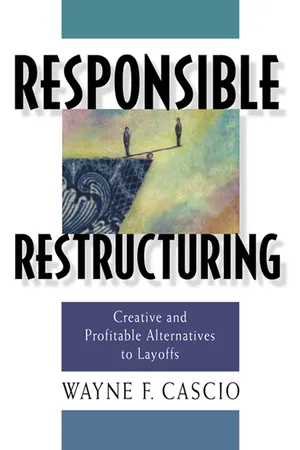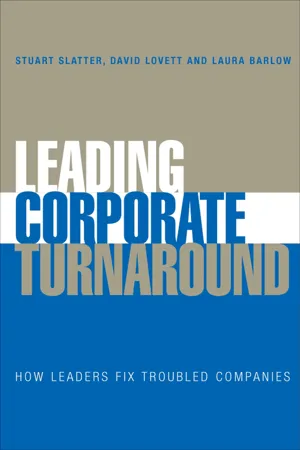Business
Restructuring
Restructuring involves making significant changes to the organizational or operational structure of a company. This can include downsizing, reorganizing departments, or changing business processes to improve efficiency or adapt to new market conditions. The goal of restructuring is often to streamline operations, reduce costs, and position the business for long-term success.
Written by Perlego with AI-assistance
Related key terms
Related key terms
1 of 4
Related key terms
1 of 3
7 Key excerpts on "Restructuring"
- eBook - ePub
Corporate Level Strategy
Theory and Applications
- Olivier Furrer(Author)
- 2016(Publication Date)
- Routledge(Publisher)
Finally, some innovations in management practices diminish the advantages of scope that a firm might gain through vertical integration or horizontal diversification. As we discussed in Chapter 11, new forms of strategic alliances permit firms to benefit from economies of scope without incurring the related administrative costs. In response, many firms have reduced their scope through Restructuring, divestments, and outsourcing. For example, long term strategic alliances between a firm and its suppliers offer a viable economic alternative to vertical integration and competitive bidding, as in the automotive industry.However, Restructuring is not always cause by internal or external problems. For example, Capron et al. (2001) argue that resource redeployments and asset divestitures after an M&A might provide a means of reconfiguring the structure of resources within the firm and that asset divestiture could be considered as a logical consequence of this reconfiguration process.Restructuring Strategies
In Figure 12.1 at the beginning of this chapter, the Restructuring strategies were organized into three categories: organizational Restructuring, financial Restructuring, and portfolio Restructuring. Even without an exact one to one match between the causes of poor corporate performance and the type of Restructuring strategy, specific Restructuring strategies generally should be used to target particular causes.Organizational Restructuring
Organizational Restructuring refers to significant changes in the organizational structure of the firm, including divisional redesign, changes to the management incentive system, and employee downsizing (Bowman & Singh, 1993 ; Bowman et al., 1999 ). Organizational Restructuring therefore usually helps solve internal problems, such as poor management or high costs. Its main objective is to improve efficiency.Change of organizational structure, systems, and processes
Organizational Restructuring can be defined as any major reconfiguration of the internal administrative structure (Bowman & Singh, 1993 ). In Chapter 10 , we argued that as firms grow and diversify, coordination and control problems and crises are likely, requiring changes in the organizational structure of the firm (Churchill & Lewis, 1983 ; Greiner, 1972 ). We also have contended that different corporate level strategies might require different organizational structures (e.g., Chandler, 1962 ). For example, related and unrelated diversification strategies need to be supported by different multidivisional structures (Hill & Hoskisson, 1987 - eBook - ePub
The Stress Test Every Business Needs
A Capital Agenda for Confidently Facing Digital Disruption, Difficult Investors, Recessions and Geopolitical Threats
- Jeffrey R. Greene, Steve Krouskos, Julie Hood, Harsha Basnayake, William Casey(Authors)
- 2018(Publication Date)
- Wiley(Publisher)
Every Restructuring situation starts as a healthy business with all the hopes of being successful. It is a complex process to return a business to viability after suffering through a period of financial and operational distress. Most Restructurings are multidimensional and require a combination of capabilities, including strategic planning, stakeholder management, operational transformation, cash flow management, and M&A expertise—essentially every element of the Capital Agenda. In addition to bringing a diverse set of capabilities together, Restructuring increasingly involves an international legal dimension. Legal regimes in developed economies differ, sometimes significantly, in how to address corporate rehabilitation. Understanding the options, strategies, and pitfalls of one Restructuring regime versus another requires broad knowledge of multiple legal systems and their relative merits in a particular situation. All of these factors converge to create a rich but complex environment for restoring corporate health—once described as akin to playing chess on a three-dimensional board.The intricacies of Restructuring affect each company in a unique way. However, successful Restructuring processes have a common set of characteristics. These include:- Understanding the nature of operational turnarounds versus financial Restructurings.
- A recognition of how to manage the human dimension of corporate distress.
- A plan for marshaling recovery.
- The ability to maintain control of the situation.
Turnaround versus Restructuring
The term Restructuring is used in a variety of ways to describe how a company deals with financial and operational distress. In some contexts, the term is interchangeable with turnaround and transformation. However, it is important to use precise definitions because turnarounds and Restructurings are distinct concepts.Turnaround
A turnaround generally refers to improving and restoring a company’s profitability and cash flow. Turnaround can equally apply to a healthy company making changes to an underperforming division, and to a distressed company urgently looking to improve its cash flow. A turnaround can be limited in scope or include sweeping changes to the enterprise. Public companies often refer to turnaround activities as a transformation program because the term transformation has a slightly more affirmative ring to it. Figure 14.1 - eBook - ePub
Responsible Restructuring
Creative and Profitable Alternatives to Layoffs
- Wayne F Cascio(Author)
- 2002(Publication Date)
- Berrett-Koehler Publishers(Publisher)
financial Restructuring, which refers to a change in the configuration of a firm’s financial or physical assets, and its financing of debt or equity. Nor does it imply a change in the configuration of a firm’s information resources, such as downsizing or upsizing its information technology infrastructure. As noted earlier, organizational Restructuring refers to planned changes in organizational structure that affect the use of people.IS Restructuring A BAD THING TO DO?
No. Kodak, an old-line company that sold cameras and film in the early 20th century, is struggling to turn around its businesses in a digital era. Some form of Restructuring is healthy—and needed. Likewise, companies that find themselves saddled with nonper-forming assets or consistently unprofitable subsidiaries should consider unloading them to buyers who can make better use of those assets. Sometimes the process of Restructuring leads to layoffs and losses of jobs, especially when the jobs relied on old technology that is no longer commercially viable. This was the case in the newspaper industry when most metropolitan dailies switched from hot to cold (computer-based) typesetting. There simply was no longer a need for compositors, a trade that had been handed down from generation to generation. However, indiscriminate “slash-and-burn” tactics, such as across-the-board downsizing of employees, seldom leads to long-term gains in productivity, profits, or stock prices, as we shall see. There is another way, and that way is known as responsible Restructuring.6RESPONSIBLE Restructuring—WHAT IS IT?
In 1995, I wrote a publication for the U.S. Department of Labor entitled Guide to Responsible Restructuring.12 As I investigated the approaches that various companies, large and small, public and private, adopted in their efforts to restructure, what became obvious to me was that companies differed in terms of how they viewed their employees. Indeed, they almost seemed to separate themselves logically into two groups. One group, by far the larger of the two, saw employees as costs to be cut. The other, much smaller group of firms, saw employees as assets to be developed. - eBook - ePub
Leading Corporate Turnaround
How Leaders Fix Troubled Companies
- Stuart Slatter, David Lovett, Laura Barlow, David Lovett, Laura Barlow(Authors)
- 2011(Publication Date)
- Wiley(Publisher)
10Financial RestructuringIT IS CLEAR THAT EVEN IF THE TURNAROUND LEADER CAN BLEND all the other key ingredients of a successful turnaround but the business is left unable to service its capital structure, all that effort will have been for nothing since covenant and other loan document breaches will soon recur. The financial structure of the company must invariably be renegotiated to align it to the needs and capacity of the new business that arises from implementation of the other key ingredients. A financial Restructuring normally becomes necessary in companies where, consequential to many factors, the financial stakeholders’ risk/reward balance has been distorted or broken. We say normally because in the case where investors acquire discounted debt with the intention of benefiting from an upcoming Restructuring, they may actively precipitate a Restructuring in order to maximize their returns.The objectives of a financial Restructuring are threefold:1. To establish a stable capital structure, commensurate with the enterprise value and cash-generating capacity of the revitalised business2. To ensure that the new capital structure reflects correctly the economic interests of those stakeholders who will support the company through its turnaround and does so on the basis of a balance that is satisfactory to themselves, other stakeholders and the company. The new structure will rarely be the same as existed at the time of the initial participation or investment, but will reflect the additional perceived and sometimes actual risk that exists in the relationship.3. To restore the risk profile (particularly in relation to credit extended to the company) to that accepted at the time of making the original credit available, subject to the requirements of the first two objectives. This is normally measured in terms of leverage and other financial ratios, asset coverage and other covenanted performance criteria. - eBook - ePub
Making Sense of Change Management
A Complete Guide to the Models, Tools and Techniques of Organizational Change
- Esther Cameron, Mike Green(Authors)
- 2024(Publication Date)
- Kogan Page(Publisher)
On a macro level, the survey found that during the 1990s the top 50 UK companies moved from having on average one major reorganization every five years to having one every three years. On a micro level, individual managers had personally experienced seven reorganizations within their organizations. Not all of the seven were major organization-wide change, some were more local. Nonetheless managers encountered various challenges as a result: managing the changes within themselves, managing the changes within their staff, ensuring that both large-scale and minor changes were aligned to the wider organizational strategies, and last but by no means least, delivering on business as usual and ensuring staff were motivated to deliver on business as usual.Reasons for Restructuring
We are concerned in this chapter with the dynamics of change and Restructuring, less so with why the organization or part thereof is being restructured. Restructuring can occur for numerous reasons:- downsizing or rightsizing (market conditions or competitiveness);
- rationalization or cost-cutting (market conditions or competitiveness);
- change in operating model (strategy implementation);
- efficiency or effectiveness (drive towards internal improvement);
- decentralization or centralization (drive towards internal improvement);
- flattening of the hierarchy (drive towards internal improvement);
- change in strategy (strategy implementation);
- merger or acquisition (strategy implementation);
- new product or service (strategy implementation);
- cultural change (strategy implementation);
- internal market re-alignment (strategy implementation);
- change of senior manager (leadership decision);
- internal or external crisis (unforeseen/unplanned change).
We believe that Restructuring should only take place as a result of a change in strategy. It should have a clear rationale and should be done in conjunction with other parallel changes such as process change and culture change. Of course this is not always the case. Sometimes other events kick off Restructuring processes, such as a new boss arriving, a process or product failure, an argument, a dissatisfied client or an underperforming person or department. In these cases it is sometimes difficult for employees to curb their cynicism when changes in structure seem to be a knee-jerk reaction that lacks direction, appears cosmetic and fails to lead to any real improvement. - eBook - ePub
Managing Through Turbulent Times
The 7 rules of crisis management
- Anthony Holmes(Author)
- 2011(Publication Date)
- Harriman House(Publisher)
12. Downsizing
There are several euphemisms used to describe the deliberate contraction of the business. Downsizing, rightsizing, Restructuring, rationalisation are some of them used frequently. Whatever name you attach to the process the programme objective is to establish a new balance between revenue, margins and costs. In most companies the effects of economic turbulence are experienced financially and the instinctive response is to reduce costs and increase margins but not to increase revenues. Usually, a target cost saving is set and a plan formulated for how the company can be downsized to operate at this lower level of fixed cost. Before we move to a detailed discussion about downsizing and cost-cutting I want to emphasise something of critical importance.I believe that for the company to avoid multiple periods of cost-cutting during turbulent times is not just idealistic but psychologically important and worth striving for, especially in announcing lay-offs.There is nothing more unsettling for employees and other stakeholders than to experience a series of downsizing initiatives. There is nothing more motivating than to be told that this is the only programme of lay-offs and that you are one of the people chosen to be retained because we believe you can make the restructured business work.Of course things change and my persistent theme about building organisational flexibility is predicated on this as an expectation. Hence, it is sometimes necessary to respond to unexpected events by changing the shape of the organisation more than once, but this should be because there has been a recognisable additional event and not because the initial downsizing was inadequate or misconceived.It is not unusual for a company that encounters difficulties in turbulent times to formulate and finance a downsizing plan to address them, but for the plan to fail to deliver the expected benefits according to the time schedule. It is this failure to deliver that moves managers from the mode of negotiation to confrontation. - eBook - ePub
How to Increase the Value-added of Controlling
A Guide to an Efficient and Sustainable Management Support
- Valerian Laval(Author)
- 2018(Publication Date)
- De Gruyter Oldenbourg(Publisher)
7 Enhancement of organization with portfolio-based RestructuringThis chapter is based on presentation from the author in November 2015 on the 3rd “International Conference on Business Administration, Marketing and Economics” (BAME) in Bratislava, Slovakia which was published in the “International Journal of Economics and Statistics” (Laval 2015d).7.1 The importance of Restructuring projects
Following the “Controlling Process-Model” set up by the International Group of Controlling (see Table 7.1 ) the scope of this chapter can be primarily allocated to the process ten which covers the “enhancement of organization, processes, instruments and systems.Besides the general management support, the controlling function can contribute its specific competencies out of other controlling processes such as “forecasting”, “cost accounting” or “project and investment controlling” to make Restructuring projects a success. Also the knowledge of processes such as “strategic planning” or “operative planning” add to the expertise of the controlling department that offers its support in Restructuring projects. On the other hand, it has to be pointed out, that the controlling department does not have a monopoly to provide such support to the top management, but that it stands in an internal and external competition. The chapter aims to contribute to the understanding of how the controlling function can apply its competencies to play an influential role in Restructuring situations.The volatile business environment and the constantly increasing global competition are forcing companies to regularly strengthen their competitive base. Companies who do not review their cost structure risk to slowly eroding their competitive position. The chapter will outline how the performance of Restructuring projects can be increased by combining potential measures in an optimized way. For this, the chapter will introduce six characteristics to evaluate Restructuring measures and explain how to balance them to the specific Restructuring needs of the company using portfolio management techniques.
Index pages curate the most relevant extracts from our library of academic textbooks. They’ve been created using an in-house natural language model (NLM), each adding context and meaning to key research topics.
Explore more topic indexes
Explore more topic indexes
1 of 6
Explore more topic indexes
1 of 4






